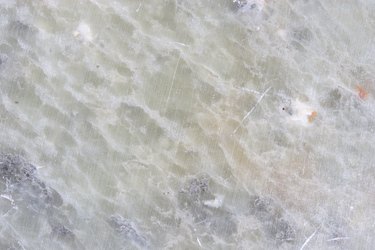
Soapstone is an attractive-looking metamorphic rock made largely of talc, and has long been used for both practical and decorative purposes. Soapstone can be carved into a wide range of objects, from pots and pans to statues and ornaments to vases and jewelry boxes. If you are thinking about getting into soapstone carving, you should learn how to identify this versatile rock by recognizing its key properties.
Step 1
Scratch the surface of the stone with your fingernail. Soapstone is very soft; it is assigned a rating of 2 on the Mohs Hardness Scale. This means that simply by drawing your fingernail across the surface of the stone you should be able to mark it.
Video of the Day
Step 2
Rub the stone. There should be a waxy, soapy feel to the surface of the stone, whether it is polished or not. This is one of the essential properties of soapstone.
Step 3
Hold the stone up to the light. When you are looking at the way the light reflects off the stone, you are looking at luster. The luster of a piece of soapstone can be described variously as greasy, pearly or silky, depending on the variety of soapstone. Also look to see if light comes through the stone. Soapstone is semi-transparent.
Step 4
Judge the stone's temperature. Soapstone, like jade, is cool at room temperature.
Step 5
Ask what it is being called. There are several types of jade that are actually varieties of soapstone. Fukian jade, Honan jade, Manchurian jade and Soochow jade are all types of soapstone.
Tip
Remember that color is not a consideration when you are looking at soapstone. Soapstone can be found in a number of different colors, as a result of the minerals that have mixed with it. Green and pink soapstone is very common in China, and black soapstone can be found in Russia.
Soapstone is non-toxic. In fact, you can put some in the freezer and later use them to chill alcoholic drinks without dilution.
Video of the Day